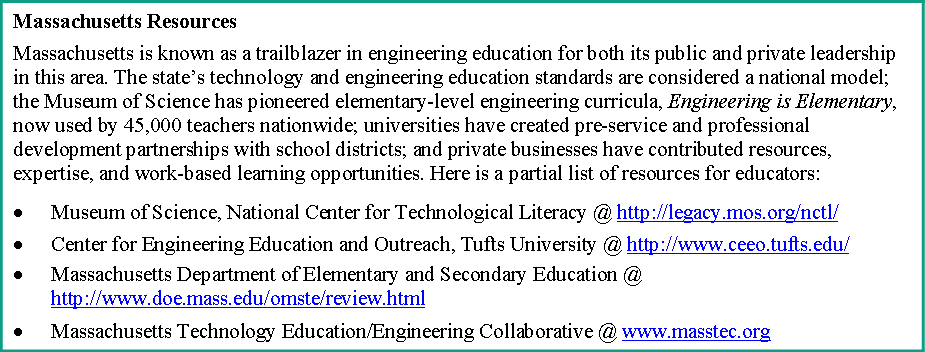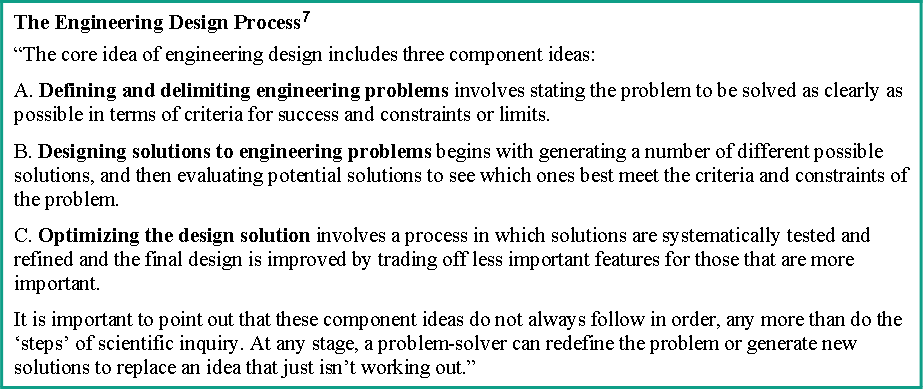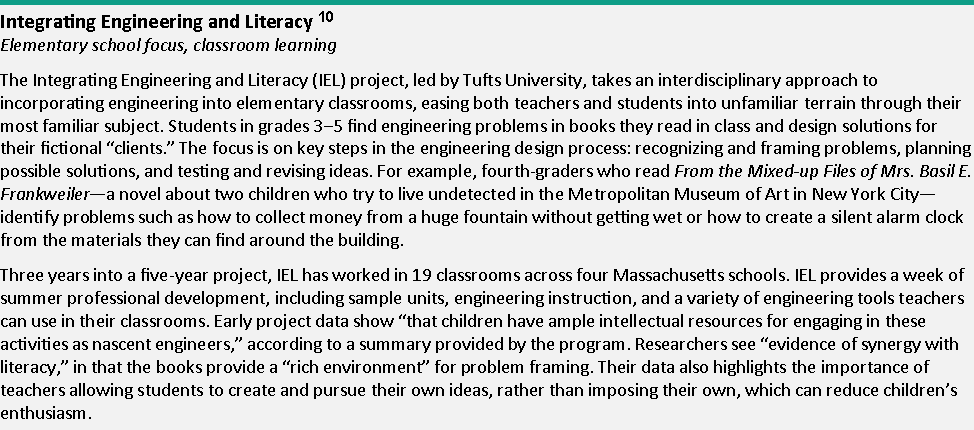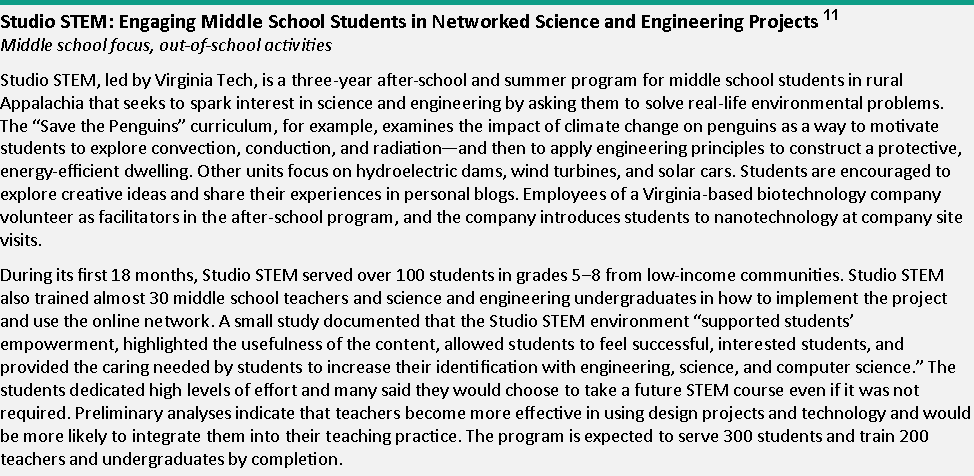
THE PROBLEM
Many of the biggest problems facing the United States and the world require engineering expertise to solve: climate change, feeding a growing population, energy independence, access to clean water, crumbling infrastructure, and others. And with global economic competitiveness inextricably linked to innovation, employers across a wide range of engineering and non-engineering fields such as health care, management, and marketing are seeking employees with engineering knowledge and related skills. These skills include the ability to creatively and systematically solve ill-defined problems, collaboratively work in teams, effectively communicate, and address ethical considerations. Meanwhile, scientific literacy—including engineering concepts—is more important than ever to understanding current events and participating effectively in our democracy.
Engineering is taught only sporadically in K-12 schools, despite growing evidence that engaging in engineering education leads to improved student learning and achievement in mathematics and science, in part by connecting these subjects to real-world problems.
Until recently, our K–12 education system had virtually ignored these needs. Although “STEM” has been part of the education lexicon for years, the “E” for engineering has received little attention from K–12 educators. Mathematics is an educational staple from the earliest grades through graduation; science is common in middle school and high school; and technology is gaining ground. But engineering is taught only sporadically in K–12 schools, despite growing evidence that engaging in engineering education leads to improved student learning and achievement in mathematics and science, in part by connecting these subjects to real-world problems.1 Seen almost exclusively as the responsibility of postsecondary education and graduate school, engineering has been viewed as too advanced for younger students, and until recently, little research has supported greater integration at the K–12 level.
A NEW FOCUS ON THE “E” IN STEM
Over the past five years, national interest in engineering education has been growing.2 More schools are incorporating engineering lessons—creating windmills, designing water filtration systems, planning buildings of the future—and more out-of-school programs are offering engineering activities. The National Assessment of Educational Progress, known as “The Nation’s Report Card,” will launch a new exam on engineering and technology in 2014. President Obama has called for new federal investments to increase STEM achievement and train 10,000 new American engineers every year.
A state-led effort to create the first-ever set of common K–12 academic standards in science is also raising the profile of engineering and could result in many more schools integrating engineering into their curriculum. The Next Generation Science Standards (NGSS), which were released in the spring of 2013, place engineering design on equal footing with physical science, life science, and earth and space science. The standards aim to outline the essential knowledge and skills that all students need in order to be ready for college and careers in each discipline in the 21st century. They emphasize engagement in the practices of science and engineering and conceptual understanding over memorization of facts. The standards are voluntary; it is up to each state to decide whether to implement them. But 26 states were involved in creating the NGSS and will consider adoption. Early versions received criticism for both including too much engineering and for not including enough. But the final version appears to be a compromise that balances what is important to teach with what is possible to teach, according to Cary Sneider, associate research professor at Portland State University, who helped lead the engineering writing effort of the NGSS.
While it is too early to predict how many states will embrace the NGSS, most states already include engineering in their academic standards, though to varying degrees. Many build on work of the International Technology and Engineering Educators Association, which has been a leader in standards design. A 2012 study in the Journal of Engineering Education identified 41 states with engineering content in their standards, and 36 of these were deemed to have “a strong presence of engineering.”3 The study calls Massachusetts, which wrote its own K–12 engineering standards in 2001 and administers technology/engineering assessments in grades 5, 8, and 10, as “the standard-bearer for pre-college engineering standards.” (See box.) Topics cover material properties and use of primitive tools through sophisticated design problems and knowledge of evolving technologies such as bioengineering and thermal systems. For younger students, the state requires that one quarter of elementary school science teaching comprise engineering and technology instruction.

BENEFITS OF ENGINEERING EDUCATION
Despite the growing prevalence of educational standards in engineering, it is estimated that only 10 percent of K–12 students are exposed to engineering-related coursework in school.4 Many students and even some teachers are confused about what exactly engineering is: they view engineers primarily as builders or construction workers.5 Clearing up these misperceptions would be one of many benefits of bringing engineering education to elementary, middle, and high schools across the country.
One misconception about engineering is that it is just applied science. According to the 2012 study of engineering education standards, “Engineering is iterative design and the optimization of materials and technologies to meet needs as defined by criteria under given constraints. Engineers use systematic processes, mathematical tools and scientific knowledge to develop, model, analyze and improve solutions to problems.”6 Engineering is used to create new or improved products, such as fiber optics, pacemakers, and satellites, in fields as diverse as energy, biomedicine, and aerospace. The engineering design process—identifying problems, evaluating options, and optimizing solutions—is critical to the work of engineers and has beneficial applications to many kinds of problem solving. (See box.)

Of all the reasons proponents give for expanding K–12 engineering education, the need to develop a large pool of talented engineers to fill the jobs of the future and help keep America innovative and competitive is certainly the most evident. Exposing students to engineering experiences long before they make college and career decisions increases the likelihood they may pursue engineering, says Greg Pearson, senior program officer at the National Academy of Engineering. Increasing their engineering knowledge is also likely to improve their ability to succeed in other careers of the 21st century, from health care to home improvement. “Industry, in particular, has desire to have access to the best and brightest who want to go into engineering,” Pearson says. “But the country as a whole can benefit from this exposure [to engineering education] even if it’s brief and not leading to a career as an engineer.”
Engineering education could yield more immediate academic benefits, as well. Engineering practices involve mathematics, science, and technology, inherently integrating all four STEM disciplines. Many scientists and educators agree an integrated approach will deepen STEM learning and help build the critical 21st century skills students need for college and career success. These include group work, problem solving, data collection and analysis, communication of complex ideas, computer modeling, and concepts like tradeoffs and optimization.
Currently, most schools teach STEM subjects separately, making few connections in curricula or student activities. But rarely do scientists, engineers, or mathematicians carry out research and development in single-discipline silos. More often, interdisciplinary teams work together to solve problems, and many collaborate with sales, marketing, and finance departments.
Another major benefit of engineering education is the crucial role of hands-on activities that attempt to solve real-life problems. These are expected to expand the appeal of science to students with little previous interest. They are more likely to see science as a subject that is not only interesting, but is also relevant to their own lives and important to improving society at large.
These factors can be especially motivating to students from groups underrepresented in STEM fields—namely, women and minorities. While only 16 percent of engineering majors are women, even fewer are from non-Asian minority groups. About nine percent of engineering majors are of Hispanic background, and just five percent are African American.8
Norman E. Fortenberry, the executive director of the American Society for Engineering Education, says he is excited about the opportunities to make the profession more diverse. “We have to actively seek out different types of students if the profession is going to survive,” he says. “We need many more women, many more persons from underrepresented minority groups, people who used to be thought of as those who would go into the arts…. We need people with different perspectives and different thought processes to contribute to the most successful engineering systems.”
THE CHALLENGES OF IMPLEMENTATION
For students in states that adopt the NGSS or their own engineering standards, big changes will be coming. Currently, science is often not taught at the K–3 level, and many students don’t take chemistry, physics, and earth science classes in high school. Engineering is taught least of all. While the details of implementation are far from decided, engineering would be taught more often at every grade level, beginning in kindergarten and through 12th grade. While some are puzzled by this approach, others see it as the most natural thing in the world. Fortenberry says it is particularly important in the youngest grades. “The youngest students are natural engineers. They want to build things, they want to put things together… and knock them down.”
The National Academy of Engineering has observed that most schools will be starting from scratch in terms of identifying curricula and assessments, and in preparing teachers. Fortunately, many rich curricula already exist that teachers will be able to draw upon for lessons, Sneider says. From the ever-popular bridge-building activity to biomimicry—in which high school students may build a functioning model of a hand—ideas abound. However, there is work to be done to align many of these activities and curricula to engineering concepts and practices in standards, and to ensure that they portray engineering in ways likely to be meaningful to students from a broad range of ethnic and cultural backgrounds.
There is also the big question of when—or even whether—there will be common NGSS assessments, as there will be for the Common Core State Standards forMathematics and English Language Arts. There is currently no funding from the federal government, as there was with the Common Core. But the National Research Council, which developed the framework for the science standards, is now working on a report to guide the development of assessments that could be used by states that decide to adopt the NGSS.
Hiring engineering education specialists will be crucial to implementing new curricula, especially at the high school level, Fortenberry says. This means that pre-service certification requirements must be developed, he adds. A few universities offer engineering education programs, but not nearly enough. In addition, many teachers, especially in elementary and middle schools, will need exposure to the most basic engineering concepts before they can start learning what to teach and how to teach it. “It’s been an immense challenge thus far in terms of pre-service preparation in math and science, and now we have to do that in engineering in terms of knowledge, and—frankly—in terms of fear,” Fortenberry says. “We’ve got to demystify and build a comfort with engineering. We need to promote greater understanding of who engineers are and what they do.” However, the National Academy of Engineering has reported that professional development opportunities for engineering are “few and far between.”9 Most last less than one week and lack ongoing support following a formal program.
Plus, underlying everything is the time crunch because of pressure to improve basic literacy and math skills as required in the Common Core, along with the financial strain on state departments of education and local schools to pay for all of the changes.
PROMISING PROGRAMS
The National Science Foundation is a major supporter of engineering education—and the research needed to ensure effective programming and skilled teachers. The following are three examples of NSF-funded programs that show promise for educating future generations of scientifically literate and engineering-talented adults.



CONCLUSION
Developing more engineers—and people with engineering competencies—is absolutely critical to the future of American and world society. Our nation needs engineers—almost 2.4 million in the next five years alone—but also many more people with an understanding of engineering in a wide variety of jobs, in government, law, medicine, and more.13 This is critical not just to the smooth functioning of our economy, but also to our democracy, as more and more personal and public decisions will require engineering knowledge.
While the NGSS and some state standards contain the foundation of engineering knowledge needed for K–12 students, those who want to pursue engineering in higher education and careers will need to continue their studies in college and possibly graduate school. But for millions of other students in any state or district incorporating quality engineering education into its curriculum, the new emphasis will go a long way toward developing a scientifically literate society.
1 National Research Council. (2009). Engineering in K–12 education: Understanding the status and improving the prospects. Washington, DC: The National Academies Press.
2 Carr, R. L., Bennett, L. D., Strobel, J. (2012, July). Engineering in the K–12 STEM standards of the 50 U.S. states: An analysis of presence and extent. Journal of Engineering Education, 101(3), 539–564.
3 Engineering in the K–12 STEM standards of the 50 U.S. states: An analysis of presence and extent.
4 National Academy of Engineering. (2010). Standards for K–12 engineering education? Washington, DC: The National Academies Press.
5 Engineering in the K–12 STEM standards of the 50 U.S. states: An analysis of presence and extent.
6 Engineering in the K–12 STEM standards of the 50 U.S. states: An analysis of presence and extent.
7 National Research Council, National Science Teachers Association, American Association for the Advancement of Science, Achieve. (2013). Excerpt from “Next Generation Science Standards: Appendix I—Engineering Design in the NGSS.”
8 Carnevale, A. P., Strohl, J., Melton, M. (2011). What’s it worth? The economic value of college majors. Washington, DC: Georgetown University Center on Education and the Workforce.
9Engineering in K–12 education: Understanding the status and improving the prospects.
10 Integrating Engineering and Literacy website: http://www.ceeo.tufts.edu/Research-Projects/integrating-engineering-and-literacy.html
11 Studio STEM website: http://blogs.lt.vt.edu/studiostem/
12 UTeach Engineering website: www.uteachengineering.org, www.engineeryourworld.org
13 Carnevale, A. P., Smith, N., Melton, M. (2011). STEM. Washington, DC: Georgetown University Center of Education and the Workforce.





